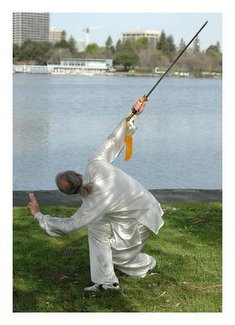I’m speaking here, of the
principle of Yang, not the style.
I’ve spoken before of my adoption of small items, when I do my Chen form. I recall a Ren Guan Yi seminar in Sebastabol, and Sifu Ren did the Double Stomp feet (this is a movement, in the 36, 38, and Form One [YiLu], where the practitioner stands, palms facing down, flips the palms and goes up and stomps one foot after the other, in a boom-BOOM! manuever). It’s hard to describe: I
felt vibrations from the ground through my feet, and when Sifu Ren did it, it was as if he exploded his root down into the ground. I found it terribly impressive. My Sifu, Dr. Johnny Jang, demonstrated it once, and his was more like a focussed, thin line of force. I watched Mark Wasson do (I think it was the 38) a form, where he did the Beast Head pose at DeAnza college, on a gym floor, and while I was sitting, I could tell how much power was expended. I watched a Chen Xiaowang video once, and he also did a double stomp (form two, ErLu) on Phoenix Spreads Wings. Dr. Jang taught me to stomp when doing Press the Elbow. Now I do two (Press Elbows), instead of one (which confuses some folks, but I’ve been told that was the traditional way to do it, so I adopted it). I’ve been told I shake the floor now.
Short version: I do a helluva lot more stomping than most people do in Chen. And, yes, I’ve limped away from practice more than once: the right foot absorbs a tremendous amount of force in this. But, when I practice in a park, I can hear the sound travel. It’s not quite gunshot loud, but pretty close. Maybe some day, I’ll be able to crack pavement. Probably never.
At this juncture in my development, my form is very, very Yang. This stems from reading and watching. I recall from the
Tao of Tai Chi (a truly wonderful book), that Chen YiLu is supposed to be 80% Yin, 20% Yang, and form two [ErLu] the reverse. However, upon viewing
Feng Zhiqiang’s VCD on Form Two, the subtitles state it should be a 60-40 variance. So I adopted this (Master Feng was a student of Chen Fake, while Jou Tsung Hwa was more the experimenter). The results are interesting.
On one occasion, as I practiced in class (Sifu Jang), a fellow student approached me after doing form two, and asked where I’d learned it. I said, “From him.” He told me it looked very different. At the Lake Merrit Bart station, another fellow came and chatted me up. He too, remarked that it was extremely masculine (he also was familiar with Sifu Jang). Told me it was the first time he’d seen someone do it like that. Occasionally, I manage to get to a group class, where everyone’s doing the same form. I’m the only one who seems to make noise: everyone else is nice and soft. The flip side is that whenever I was prevailed upon to lead the practice, by the time I was halfway through with YiLu, the rest of the class had finished it.
Most styles (all, excepting Chen and perhaps
Zhaobao) have an extreme emphasis on the Yin methodology; the concept here being that extreme Yin will result in Yang.
There are twofold points to stomping that hard: one is that the player should be careful about it. It CAN injure you. Two, is that the movement is actually used to stimulate the ‘Bubbling Well’ meridian point, located in the middle of the metatarsal ridge of the foot (the Double Stomp Feet is a two-fold rationale: one is to harm the opponent, the other to alleviate a blow to the groin). I have heard that it can be injurious, to not only the ankle/foot, but to the brain stem as well. Thus far, I’ve not suffered any deleterious side effects. But doing any form of exercise improperly for long periods can have implications. So if you stomp, try to do it softly, and build it up after time. Also, make the effort to spread the impact along the length of the foot: don’t just hit your heel or upper sole. This is what causes injury (I can speak to that from experience).
There’s only one place (that I know of) in Fu/Yang style where there’s any sort of noise, and that’s in the posture Sweep the Lotus. In Yang Jwing-Ming’s book,
Tai Chi Chuan Martial Applications: Advanced Yang Style, he tells a great story, about this posture. In olden times, it was a game played by martial artists. One literally would sweep the kick through a lotus stem, and if that person could break the reed (it’s simply standing, not held), it was a sign of great internal power. So when I practice the 42 compulsory, the 42 Fu, Fu long form (even when I used to practice the long Yang form), I always try my best to smack my palm with my foot [special note: DON’T swing your hands at the coming foot: the hands need to be stationary, the foot needs to hit THEM. Way harder, ain’t it?]. The Cheng Man-Ching variant doesn’t do this – rather, you very softly brush the toe across the stationary palms (way harder still).
Regardless of your style, Tai Chi is about balance, first and foremost. So there is a time for hardness, a time for softness, a moment of explosive movement, a moment of intense stillness, one second of being the wind, one second of being a rock.
You can live without Tai Chi. But Tai Chi can instruct you in that essential ingredient inherent in all good lives:
Exquisite timing.

